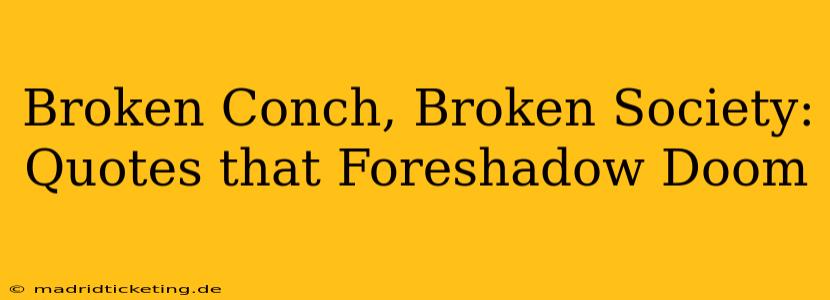The fragility of a conch shell, easily broken, often serves as a potent literary symbol representing the delicate balance of society and the impending threat of chaos. Many works of literature use broken conches—or the foreshadowing of their breakage—to symbolize the disintegration of order and the descent into savagery. This exploration delves into the power of this motif and examines specific quotes that powerfully foreshadow doom. We'll uncover the subtle nuances of these literary devices and how they enhance the narrative's impact.
What Does a Broken Conch Symbolize?
Before diving into specific examples, let's establish the core symbolism. The conch shell, particularly in its unbroken state, frequently represents civilization, order, law, and the power of rational discourse. Its delicate nature highlights the vulnerability of these ideals. The act of breaking the conch, therefore, often signifies the collapse of these structures, the silencing of reason, and the rise of primal instincts. The shattered fragments represent a fractured society, a loss of unity, and the descent into anarchy and violence.
Quotes Foreshadowing Doom: A Literary Analysis
Analyzing quotes that foreshadow the breaking of the conch—and the consequent societal breakdown—requires a nuanced understanding of context and symbolism. Let's examine some prominent examples:
"The conch exploded into a thousand white fragments and ceased to exist." - William Golding, Lord of the Flies
This iconic quote from Lord of the Flies perfectly encapsulates the theme of societal disintegration. The shattering of the conch marks the complete abandonment of reason and civilized behavior among the stranded boys. It's not just the physical destruction of an object; it symbolizes the obliteration of their fragile society, replaced by savagery and violence. The phrase "ceased to exist" emphasizes the finality of this loss, highlighting the irreversible nature of their descent into primal chaos.
Does the breaking of the conch symbolize the loss of hope?
Yes, absolutely. The conch's breakage in Lord of the Flies represents the extinguishing of hope for rescue and a return to civilization. The boys' initial attempts to maintain order and establish a structured society are directly tied to the conch. Its destruction symbolizes the loss of their last vestige of hope, signifying their complete surrender to the savagery that consumes them. The hope represented by the conch is replaced by fear, suspicion, and ultimately, violence.
How does the description of the conch contribute to the overall atmosphere of the novel?
The description of the conch, both before and after its destruction, significantly contributes to the novel's atmosphere. Initially, the conch's beauty and the power it holds create a sense of fragile hope and the possibility of order amidst chaos. As the conch's condition deteriorates, mirroring the boys' decline into savagery, the atmosphere shifts to one of increasing tension, fear, and despair. The final shattering of the conch amplifies the sense of irreversible loss and the complete breakdown of civilization.
Are there other literary works that utilize the broken conch as a symbol?
While Lord of the Flies is arguably the most famous example, the symbolic use of a broken conch or shell to represent societal collapse can be found in other works, though perhaps not as explicitly central to the narrative. The brokenness of the shell could be interpreted as a metaphor for disillusionment and the fragmentation of ideals in various contexts, extending its symbolic reach beyond the specific events of Golding's novel.
Conclusion: The Enduring Power of a Broken Symbol
The broken conch, as a literary symbol, possesses a profound and lasting impact. It transcends its literal form to represent the fragility of civilization, the seductive power of primal instincts, and the devastating consequences of abandoning reason and order. Analyzing quotes surrounding this powerful image allows us to deeply appreciate the author's skill in foreshadowing doom and highlighting the inherent tensions within human society. The enduring resonance of this symbol speaks to its capacity to evoke powerful emotions and stimulate critical reflection on the nature of human behavior and the precarious balance between civilization and savagery.

